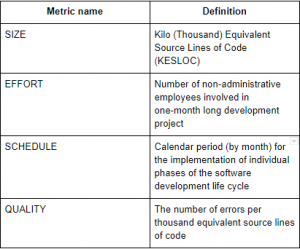For about six years, the author was able to act as coordinator of the development of program metrics in software organization which employed about 450 developers. As a member of the Software Engineering Process Group (SEPG), whose functions are defined in the Capability Maturity Model (CMM V1.1), he had to study more than 400 program metrics offered by SEI. Based on this research, he came to the conclusion that in a specific organization, only a small number of metrics should be standardized. The bulk of metrics should be developed, selected, analyzed and used by each group, depending on the development stage.
When choosing the program to create metrics for several independent software development projects, the author established a set of common measurement standards, reports on which should come from all projects and be analyzed in SEPG. But at the same time he created a process that allowed each project to define and use its own metrics, which did not need to be included in the report or transferred to other projects. A standard set of four program metrics that was proposed, approved and adopted for use in all software development projects, is described in Table 1.
Table 1. Organization-wide set of program indicators

It makes logical and financial sense to start collaborating with providers of third-party software testing services in order to cost-effectively fulfill all testing needs.
It was expected that the actual data for each of these metrics would be reported during a formal review at each of the main milestones in the development life cycle. These main intermediate stages and associated formal revisions correspond to the main stages of the Waterfall life cycle model. These include initial design (ID), detailed design (DD), unit testing (UT) and system testing (ST).
Table. 1 is a chart of actual employment-related data showing the actual staff load during the first four months (i.e., 16 weeks) and the anticipated load before the end of the project (starting from the 16th week). In the case of large-scale projects, the personnel load measurement data are broken down into stages and / or the nature of the work performed.
Comments are closed.









